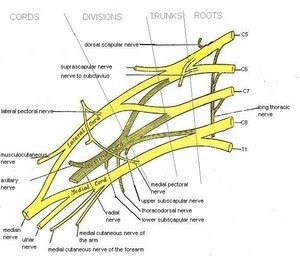Brachial plexus injuries are serious, but often preventable, birth injuries that can leave newborn babies with permanent nerve damage.
- Four decades of trial experience.
- Millions recovered in financial compensation.
- National alliance of plaintiffs’ attorneys.
Were your child’s injuries the result of medical negligence? Call our experienced birth injury attorneys today to start exploring your legal options in a free consultation.
Our birth injury lawyers understand local medical malpractice laws and know how to negotiate with insurance providers. We’ll help you get the full compensation your family is entitled to.
"Great Experience." Laurence was extremely helpful for my family.
Erb’s palsy (sometimes referred to as Erb-Duchenne palsy) is a form of arm paralysis. The condition is caused by injury to a collection of nerves that controls movement in the shoulders, arms and hands. Inappropriate medical treatment often leads to Erb’s palsy, as obstetricians struggle to deliver infants in difficult deliveries.
What Is Erb’s Palsy?
The brachial plexus nerves are essential for both sensation (feeling) and muscle control. Beginning in the base of the neck, this group of five nerves stretches across the shoulder and downwards through the armpit. Extending down the arm, the nerves of the brachial plexus transmit electrical impulses all the way to the wrists, hands and fingers.

Klumpke’s Palsy
A different disorder, known as Klumpke’s palsy, is caused by lower brachial plexus injuries. Since only the upper brachial plexus nerves have been injured, Erb’s palsy usually affects movement and feeling in the upper arm, from a child’s shoulder to the elbow. In cases of Klumpke’s palsy, a child’s lower arm and hand are affected.
The word “palsy” simply means weakness. Palsy disorders, however, often lead to a range of effects beyond weakness, including numbness, muscle atrophy and paralysis.
Brachial Plexus Injuries At Birth
Newborn infants frequently sustain brachial plexus injuries, which can lead to Erb’s palsy, during labor and delivery. In some cases, the injury is directly caused by medical negligence – when doctors, nurses or midwives fail to follow medical best practices.
Causes Of Arm Paralysis In Infants
Many children suffer brachial plexus injuries during long and difficult deliveries, when obstetric intervention becomes necessary to deliver a child safely. Shoulder dystocia, a delivery complication in which a child’s shoulders become stuck behind the mother’s pelvis, is a particular risk.
Shoulder Dystocia
Shoulder dystocia is a medical emergency. Beyond nerve damage, children who become lodged in the birth canal are also at an increased risk of suffering birth asphyxia, a form of oxygen deprivation that can lead to permanent brain damage. In order to avert serious trauma, obstetricians must intervene quickly – and carefully – to ensure the infant is delivered properly.
Doctors use a number of “maneuvers” to manage cases of shoulder dystocia. Some obstetricians will attempt to manually re-position an infant’s body, reaching into the vagina completely. In most cases, the doctor will apply traction to the infant’s head, pulling downward in an attempt to draw the child’s body through the birth canal. It should be obvious that these are delicate procedures, and doctors must use extreme caution to avoid inflicting undue harm to the infant. Excessive force can stretch, tear or rip an infant’s vulnerable brachial plexus nerves.
Assisted Deliveries: Forceps & Vacuum Extraction
Many cases of Erb’s palsy are the result of assisted deliveries, in which obstetricians use forceps or vacuum extractors to pull a child through the birth canal. For obvious reasons, these devices must be used with extreme care; one false move could cause permanent damage to an infant.
In a recent Israeli study, 25% of infants diagnosed with brachial plexus injuries were found to have been delivered with the use of assistive devices – compared to only 5% in the general population.
The researchers also found that doctors frequently underestimated fetal weight prior to delivery, believing children would be smaller than they were in reality. In general, larger babies are at an increased risk of sustaining brachial plexus injuries.
Failure To Order An Emergency C-Section
Doctors can’t always predict which infants will be more likely to suffer brachial plexus injuries. But sometimes, specific risk factors make a difficult delivery highly probable. Risk factors for Erb’s palsy include:
- Maternal diabetes
- Maternal obesity
- Breech presentation
- Large infants (fetal macrosomia)
- Shoulder dystocia
In these cases, when delivering a child vaginally may be unsafe, obstetricians can order an emergency c-section to avoid unnecessary harm. Many medical malpractice lawsuits cite failure to order a necessary c-section as the cause of Erb’s palsy.
Symptoms & Signs Of Erb’s Palsy
The severity of a child’s injuries will vary depending on how the brachial plexus nerves have been damaged. These nerves can be stretched, torn or ripped completely from the spinal cord. In most cases, however, the symptoms of Erb’s palsy are recognized directly after a child’s birth:
- inability to move the upper arm
- arm bent at the elbow and held against the body
- impaired gripping abilities on the affected side
While many sources refer to a “crooked” arm, usually bent at the elbow, as a classic sign of Erb’s palsy, some children will actually appear to have excessively “loose” arms. The appearance of Erb’s palsy will depend on the specific case.
After sustaining a brachial plexus injury, many children fail to exhibit the Moro reflex, an automatic response to the sensation of falling or being dropped. After a sudden loss of support, healthy babies will quickly spread out their arms and then snap their arms tight to the body again. This reflex, which is usually accompanied by crying, is called the Moro reflex. In children who have suffered injuries to the brachial plexus, the Moro reflex is often impaired or completely absent.
Does Erb’s Palsy Cause Permanent Paralysis?
Not always. When infants have sustained only minor brachial plexus injuries, the nerves can heal over time. A few months of physical therapy, along with regular exercises and massage at home, are often enough to recover range of motion and gripping abilities in the affected arm.
But that’s not always the case. After severe injuries, especially when the nerves have been torn directly from the spinal cord, some infants will require expensive surgeries. In the most common procedure, a healthy tendon from somewhere else in the child’s body will be transplanted, promoting proper nerve growth in the brachial plexus.
Physical and occupational therapies are almost always necessary, but even after surgery, some children will never recover fully. Permanent paralysis or long-term weakness are distinct possibilities, leaving some people with Erb’s palsy unable to work or engage in leisure activities.
Associated Conditions & Effects
Erb’s palsy often has associated effects on a child’s arm. While not specifically forms of nerve damage, these muscular and circulatory complications can have disabling consequences.
With a limited range of motion and significant weakness, the affected arm can fail to develop muscles properly. Thus the affected arm can be much weaker, and even come to be smaller, than the other arm. Some patients are left unable to lift their arm above the shoulder without assistance.
In many children, Erb’s palsy also impairs the development of blood vessels in the affected arm. Without a fully-developed circulatory system, the arm has difficulty regulating its own temperature. Proper circulation is also essential in the healing of wounds, which means that kids with Erb’s palsy often live at an increased risk of infections.



